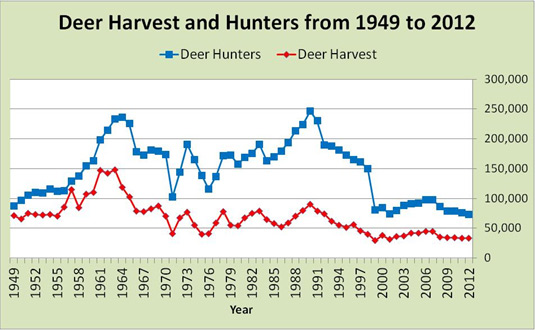Colorado Parks & Wildlife (CPW)
incorporates public expectations and peer-reviewed research into the
formulation of deer management strategies. For example, in 1999, CPW responded
to concerns about low buck numbers and declining fawn production by eliminating
over-the-counter buck licenses in favor of a totally limited licensing regime.
With strict limits in each game management unit, deer license sales dropped by
40 percent from 154,276 in 1998 to 93,020 in 1999. Post-hunt buck to doe ratios
increased dramatically from a statewide average of 17 bucks per 100 does prior
to limitation to 32 bucks per 100 does after the change. After an initial
increase from the carry-over of these new un-harvested bucks, deer populations
continued to decline (Figure3), prompting CPW to further reduce licenses in an
effort to achieve herd management objectives.

Figure 3 Historical perspective of west slope deer herds (1984–2006) on the total number of hunters
(gray line), total number of deer harvested (solid black line), and total number of adult male deer harvest (dashed black line) throughout the observed decline in mule deer populations as well as through implementation of the statewide limited harvest management plan.17
Herd Management Planning
CPW's Herd Management Planning process incorporates public input along with considerations of habitat capability and other biological factors to establish objectives for all of Colorado's 55 deer herds. Population and buck/doe ratio objective ranges are developed for each herd through a public process that takes into account biological and sociological considerations. These plans are approved by the Colorado Parks and Wildlife Commission and direct the management of herds in ten year increments.
Harvest
Accurate harvest information is essential for managing Colorado's deer herds.
Statistically valid, random telephone and internet surveys are used to estimate harvest and hunter recreation days by individual herds. The harvest surveys also provide information on where hunters hunted and animals harvested, numbers of resident and nonresident harvest, harvest by method of take and season, the sex and age (i.e., fawn or adult) of harvested animals, date of kill, and hunter satisfaction. A historic graph of hunters and harvest is presented in Figure 4.

Figure 4. Number of deer hunters and deer harvested 1949-2012.
Population Inventory and Population Size Estimation
CPW conducts post-hunt herd inventories with helicopters to estimate the number of buck deer per 100 female deer (sex ratio) and number of fawn deer per/100 female deer (age ratio). CPW inventories most deer herds west of I-25 on an annual basis. Approximately 10 percent of the estimated statewide deer population is annually classified requiring approximately 340-400 hours of flight time. Age ratios provide an estimate of the number of fawns per 100 does that were born in summer and survived until December. CPW estimates population size annually for each herd with computer models. Sex and age ratios, along with harvest and survival estimates from intensive deer monitoring areas, are the input data for models. Population estimates are compared with herd management plan objectives to determine harvest recommendations/license numbers that will move the population towards herd objectives. The average sex ratio for deer herds statewide during the past few years is approximately 30 bucks per100 does, which is consistent with the statewide objective. For western Colorado, the 3-year average has been slightly lower at approximately 28.5 bucks per 100 does.
Intensive Mule Deer Monitoring Areas
CPW created the intensive mule deer monitoring area system to better understand and estimate mule deer populations. Biologists selected five mule deer herds (Piceance Basin, Middle Park, Uncompahgre Plateau, Gunnison and Cripple Creek) that best represent mule deer herds west of I-25. CPW uses radio-collars to estimate annual adult doe survival and winter fawn survival in these five intensive monitoring areas. Winter has long been recognized as a key stressor of mule deer populations. Monitoring fawn survival from December until June, when fawns "recruit" to the adult population, reveals a lot about a herd. Recruitment is an important indicator of population performance.

Approximately 900 radio-collared mule deer are monitored annually in these five monitoring areas to determine the specific cause and timing of mortality. Survival rates from these herds are used in deer population models for the rest of the herds west of I-25. Information is also collected on seasonal habitat use, cause of mortality and location of migration corridors.

